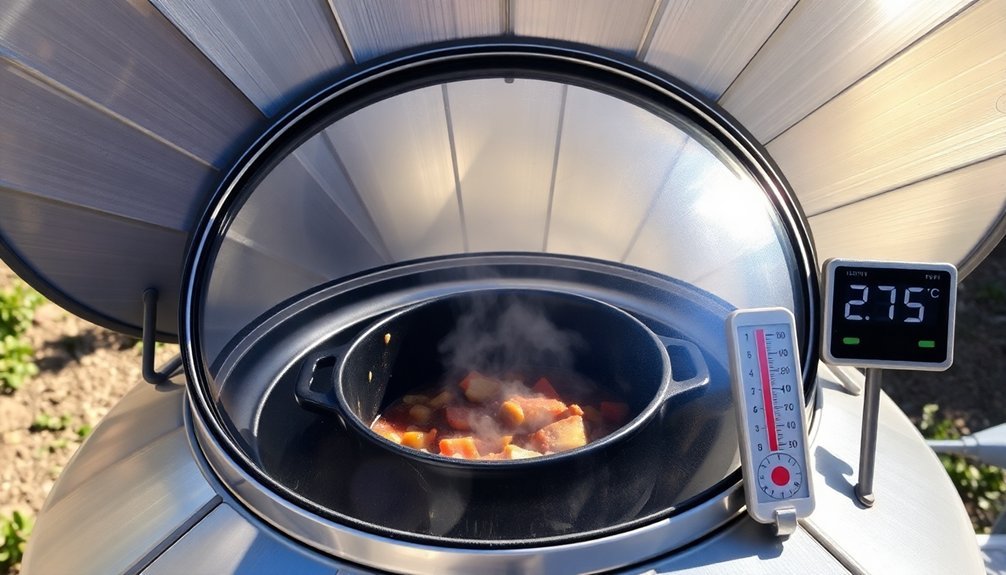When you're cooking turkey outdoors, temperature control becomes critical due to unpredictable weather conditions that can drastically affect your cooking temperatures by up to 50°F. You'll need to maintain a consistent internal temperature of 165°F in both the breast and thigh meat to guarantee food safety and prevent foodborne illness. Wind, rain, and varying sun exposure can all impact your heat source and cooking times, making it essential to use reliable thermometers and proper positioning techniques. Your outdoor turkey's quality depends on careful monitoring and adjustment of these variables – mastering these elements will transform your outdoor cooking experience.
Proper Temperature for Turkey Safety

Food safety hinges on achieving and maintaining the correct internal temperature when cooking a turkey.
You'll need to guarantee your bird reaches 165°F (74°C) in both the innermost part of the thigh and the thickest part of the breast. If you've stuffed your turkey, the stuffing must also hit this temperature.
You can use an instant-read digital thermometer for accuracy, inserting it into the crease where the leg meets the breast, avoiding bones. Starting at a higher initial temperature of 425°F for the first hour helps create a crispy exterior.
Don't rely on guesswork – regular temperature checks are essential, especially during final cooking stages.
If you're planning to remove the turkey at 160°F (71°C), remember that it'll continue cooking during the rest period. This temperature-time relationship is important for achieving the necessary 7-log reduction in bacteria, keeping your outdoor-cooked turkey safe to eat.
Heat Distribution During Solar Cooking
When you're solar cooking a turkey, you'll need to track the sun's movement and adjust your cooker every 1-2 hours to maintain consistent heat exposure.
You can optimize thermal balance by using dark-colored cookware and ensuring your reflecting panels are properly angled to concentrate sunlight onto the cooking chamber. The effectiveness of your cooking will depend heavily on having clear, sunny weather.
The proper distribution of thermal mass at the base of your solar cooker will help create natural convection currents that evenly heat your turkey throughout the cooking process.
Sunlight Exposure Patterns
Understanding sunlight exposure patterns is essential for successful solar cooking with your turkey outdoors. You'll need to track the sun's position throughout the day, as ideal cooking occurs between 10:00 a.m. and 2:00 p.m. when sunlight is most intense. Position your cooker to capture direct rays and adjust it regularly to follow the sun's path. Using a box cooker design with an insulated transparent lid helps maintain consistent heat during the cooking process.
| Time of Day | Sun Position | Required Action |
|---|---|---|
| Morning | Low/Rising | Angle cooker upward |
| Midday | Overhead | Flatten cooker angle |
| Afternoon | Low/Setting | Angle cooker westward |
For best results, you'll want to preheat your cooker for 30 minutes in an unshaded area. Remember that seasonal changes affect the sun's height—you'll need steeper angles in winter than summer. Always protect your setup from wind to maintain consistent temperatures while cooking your turkey.
Thermal Balance Management
Maintaining proper thermal balance during solar cooking requires careful attention to heat absorption, distribution, and retention.
You'll need to position dark, thin cookware to maximize heat absorption, as dark surfaces convert UV rays into infrared radiation more efficiently. Using reflective panels made of silver, chromium, or aluminum will help concentrate sunlight onto your cooking surface.
To prevent heat loss, you'll want to use transparent covers that create a greenhouse effect, trapping the warmth inside. Adding insulating materials and ensuring a tight-fitting lid are essential for maintaining consistent temperatures.
You should adjust the cooker's angle every one to two hours to maintain ideal solar concentration. Remember, your goal is to reach a thermal balance where solar gain equals heat loss, typically achieving cooking temperatures between 73-76°C for effective food preparation.
Time and Temperature Monitoring

Proper time and temperature monitoring serves as the cornerstone of cooking a safe and delicious turkey outdoors.
You'll need to insert your thermometer probe horizontally into the deepest part of the breast, avoiding any bones. Confirm it's in the thermal center, where it's furthest from the exterior.
You should use a leave-in probe thermometer to track temperatures continuously. Set your alarms to 157°F for the breast and 175°F for the thigh.
Don't open your grill until the alarm sounds, as this causes heat loss. Once you've reached these temperatures, let your turkey rest for 20-30% of its total cooking time.
During this period, monitor the maximum temperature to ascertain it hits at least 165°F for food safety. Verify the final temperature with an instant-read thermometer before serving.
Weather Impact on Cooking
Wind, rain, and temperature swings can wreak havoc on your outdoor turkey cooking, making it essential to monitor heat distribution carefully.
You'll need to adjust your cooking strategy as weather conditions can cause temperature variations of up to 50°F in your grill or smoker.
Direct sunlight and strong winds particularly affect heat zones in your cooking setup, so you'll want to position your grill strategically and check temperatures across multiple points of your turkey.
Heat Distribution Challenges
When cooking turkey outdoors, you'll face several heat distribution challenges that can affect your results. Uneven heat sources, caused by wind and rain, can make it difficult to maintain a stable temperature throughout your cooking session. You'll often need more coals than initially planned, and equipment failures can further complicate the process.
| Challenge | Impact | Solution |
|---|---|---|
| Wind | Unstable temperatures | Use windbreaks |
| Rain | Longer cooking times | Install cover/shelter |
| Microclimates | Uneven cooking | Rotate turkey regularly |
| Equipment issues | Inconsistent heat | Have backup equipment |
To overcome these challenges, you'll need to monitor your grill's temperature constantly and make necessary adjustments. Pay special attention to preventing food from falling into the coals, which can lead to burning and temperature fluctuations. Consider using a propane grill for more consistent heat distribution in challenging weather conditions.
Temperature Fluctuation Effects
Understanding temperature fluctuations in outdoor turkey cooking requires careful attention to weather conditions.
You'll need to monitor how rain, wind, and snow affect your grill's temperature stability. High humidity speeds up cooking by reducing moisture evaporation, while low humidity does the opposite.
At higher altitudes, you'll face additional challenges as water boils at lower temperatures, requiring adjustments to your cooking time and temperature.
- Monitor your grill's temperature more frequently during unstable weather conditions
- Add 15-20 minutes per pound to cooking time in cold weather
- Protect your propane tank from direct sunlight to prevent fuel temperature issues
- Shield your grill from snow and rain to prevent rust and component damage
These weather-related factors directly impact your turkey's cooking consistency and your grill's performance, making constant monitoring essential.
Turkey Size and Positioning

Selecting the right size turkey for your outdoor cooker determines your cooking success. If you're using a WSM smoker, you'll need to match your turkey to your model – an 18.5" WSM handles up to 30 pounds, while a 22.5" WSM can fit a 40-pound bird. For Weber kettles, stick to turkeys under 15 pounds.
Proper positioning is essential for even cooking. You'll want to center your turkey over the heat source and use a vertical roasting stand for larger birds.
If you're cooking multiple turkeys, use both grates and maintain 325-350°F. For the best results, choose broader, flatter turkeys that fit within your cooker's circumference.
Don't forget to place a foil pan under the top turkey when cooking two birds to prevent dripping issues.
Testing Internal Meat Temperature
Getting your turkey's internal temperature right can make or break your outdoor cooking success.
You'll need an instant-read digital thermometer to check multiple spots, especially the thickest parts of the breast and thigh meat. For best results, avoid touching bones or fat when inserting your probe, as these can give false readings.
- Insert the thermometer into the breast's deepest part, aiming for 165°F (74°C), though you can pull it at 160°F (71°C) if you'll let it rest.
- Check the thigh-body joint, targeting 165-180°F (74-82°C) for tender dark meat.
- Test the drumstick-thigh connection for even cooking.
- Verify stuffing temperature reaches 165°F (74°C) if your turkey's stuffed.
Frequently Asked Questions
How Does Wind Speed Affect Turkeys' Ability to Regulate Body Temperature?
Wind speed helps you understand how turkeys regulate temperature, as it cools their wattles and bodies. You'll notice higher winds provide better cooling, while lower speeds don't help them control heat as effectively.
Can Turkey Breeds Differ in Their Natural Heat Tolerance Levels?
Yes, you'll find heritage turkey breeds like Bourbon Red have better natural heat tolerance than commercial breeds. They've developed stronger genetic adaptations for temperature regulation through their diverse ancestry and natural breeding patterns.
What Role Do Ground Temperature Variations Play in Turkey Comfort Outdoors?
You'll find that ground temperature variations greatly affect your turkeys' comfort. They seek cooler soil in summer and warmer ground in winter, helping them naturally regulate their body temperature throughout the day.
How Do Seasonal Feather Changes Impact Turkeys' Temperature Regulation Abilities?
You'll notice turkeys adapt their feathers seasonally – thicker, fluffier ones in winter trap warmth against their skin, while lighter summer feathers allow more airflow. These changes directly affect how well they regulate their body temperature.
Do Turkey Age Groups Respond Differently to Outdoor Temperature Fluctuations?
Yes, you'll notice young turkeys struggle with temperature changes, needing warmer conditions (25-35°C), while mature birds handle fluctuations better. Adults can tolerate cold temperatures near freezing, but they'll avoid extreme heat.
In Summary
When you're cooking turkey outdoors, proper temperature control isn't just about taste – it's essential for your safety. You'll need to maintain consistent heat between 325-350°F and guarantee the internal temperature reaches 165°F to kill harmful bacteria. Weather conditions can affect your cooking time and temperature, so you must monitor closely and adjust accordingly. Don't risk serving undercooked turkey that could make your guests sick.





Leave a Reply